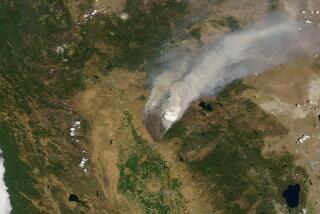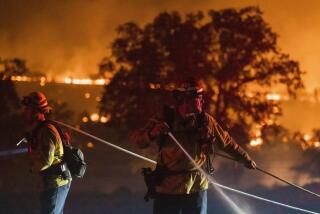Crews make progress on 150,000-acre Rim fire near Yosemite
Firefighters gained ground Monday on the Rim fire raging in and around Yosemite National Park as it grew to the size of Chicago, charring nearly 150,000 acres.
As it continued to push up from the southwest, firefighters got a slight reprieve from frustratingly erratic winds that have characterized conditions for several days. The blaze is now 15% contained, according to fire officials.
In an area with a recent history of fatal fires, officials said they are cognizant of the challenges crews are facing: rugged terrain, dry fuel and wind.
The head of the fire blazed north into Yosemite toward a granite rock formation, scorching 21,775 acres, about 3% of the park’s total area, said park ranger Kari Cobb.
The rough terrain has proved challenging for crews since the fire was spotted Aug. 17, but the granite could be an effective natural barrier that could slow or stop the flames, said Johnny Miller with the California Department of Forestry and Fire Protection’s public information bureau.
Though 15% containment – up from 7% on Sunday – seems low, Miller said, it’s a good number considering what firefighters are up against.
“Everything is looking as good as it possibly can for this stage of the fire,” he said. “We’re making good progress.”
According to the National Weather Service, wind gusts were topping out at 15 mph without significant shifts in direction. A prevailing wind from the Pacific could push flames up mountainsides, officials warned.
Moreover, the remnants of Tropical Storm Ivo, floating north from Mexico, were expected to stay south of the flames, sparing crews any start-ups from wayward lightning strikes.
“The fire itself may be far enough north to stay out of the deeper moisture and thunderstorm threats,” said meteorologist Jim Dudley. “The greatest threat of thunder should remain east of the Rim fire. It’s good news.”
Temperatures in the Yosemite Valley region were expected to remain in the mid-90s the rest of the week, Dudley said.
Visitation to the park has taken a slight hit, but the effect has been minimal, Cobb said. Campgrounds are still full, and the majority of the park, including Yosemite Valley, remains smoke-free, she said.
Federal officials have approved the state’s request for assistance with firefighting, with the Federal Emergency Management Agency reimbursing up to 75% of eligible costs, according to FEMA. The state submitted the request for funds last week as the Rim fire exploded in size.
Gov. Jerry Brown toured the area Monday and met with fire officials and first responders, saying President Obama had called him to express support and offer assistance.
“This is something that we have to live with -- it may even get worse in years to come -- but California will be ready for it,” Brown said at a news conference.
On Friday, Brown extended a state of emergency to include the county and city of San Francisco. Earlier last week at the Hetch Hetchy reservoir, the San Francisco Public Utilities Commission had to shut down two of its three hydroelectric power stations because of the fire.
Supplementary power has cost the San Francisco PUC $600,000 since the two stations were shut down last Monday, said Tyrone Jue, a spokesman for the agency. There is no timetable for when the stations will be back online, he said.
Officials are also monitoring the quality of water from the Hetch Hetchy reservoir, which has not been affected, according to the San Francisco PUC.
ALSO:
Mother, boyfriend arrested after baby dies at Inglewood hospital
Westlake football hazing allegations: Students, parents surprised
As Camp Pendleton holds training, blasts might be heard for 50 miles
Twitter: @Sam_Schaefer | @josephserna
Samantha.Schaefer@latimes.com | Joseph.Serna@latimes.com
More to Read
Sign up for Essential California
The most important California stories and recommendations in your inbox every morning.
You may occasionally receive promotional content from the Los Angeles Times.












